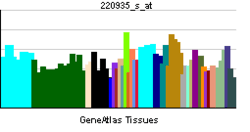CDK5RAP2
| View/Edit Human | View/Edit Mouse |
CDK5 regulatory subunit-associated protein 2 is a protein that in humans is encoded by the CDK5RAP2 gene. Multiple transcript variants exist for this gene, but the full-length nature of only two has been determined.[4][5] CDK5RAP2 is homologous to the Drosophila protein centrosomin (cnn).[6]
Function
Neuronal CDC2-like kinase, which is involved in the regulation of neuronal differentiation, is composed of a catalytic subunit, CDK5, and an activating subunit, p25NCK5A. The protein encoded by this gene binds to p25NCK5A and therefore may be involved in neuronal differentiation. The encoded protein may also be a substrate of neuronal CDC2-like kinase.[5]
Clinical significance
A magnetic resonance imaging study has demonstrated a link between common variation in the CDK5RAP2 gene and brain structure.[7] More specifically, associations were found between several single nucleotide polymorphisms (SNPs) and brain cortical surface area and total brain volume. These associations were found exclusively in male subjects and all SNPs were located upstream in non-exonic regions. The functional significance of these loci is not yet known. However, given their location close to regulatory elements, it is possible that they are involved in gene regulation, which suggests that common variance in brain structure could be associated with differences in gene regulation rather than protein structure, consistent with findings in other complex human traits.
Interactions
CDK5RAP2 has been shown to interact with CDK5R1.[8]
References
- ↑ "Diseases that are genetically associated with CDK5RAP2 view/edit references on wikidata".
- ↑ "Human PubMed Reference:".
- ↑ "Mouse PubMed Reference:".
- ↑ Ching YP, Qi Z, Wang JH (April 2000). "Cloning of three novel neuronal Cdk5 activator binding proteins". Gene. 242 (1-2): 285–94. doi:10.1016/S0378-1119(99)00499-0. PMID 10721722.
- 1 2 "Entrez Gene: CDK5RAP2 CDK5 regulatory subunit associated protein 2".
- ↑ Barr, A. R.; Kilmartin, J. V.; Gergely, F. (5 April 2010). "CDK5RAP2 functions in centrosome to spindle pole attachment and DNA damage response". The Journal of Cell Biology. 189 (1): 23–39. doi:10.1083/jcb.200912163. PMID 20368616.
- ↑ Rimol LM, Agartz I, Djurovic S, Brown AA, Roddey JC, Kähler AK, Mattingsdal M, Athanasiu L, Joyner AH, Schork NJ, Halgren E, Sundet K, Melle I, Dale AM, Andreassen OA (January 2010). "Sex-dependent association of common variants of microcephaly genes with brain structure". Proc. Natl. Acad. Sci. U.S.A. 107 (1): 384–8. doi:10.1073/pnas.0908454107. PMC 2806758
 . PMID 20080800.
. PMID 20080800. - ↑ Wang X, Ching YP, Lam WH, Qi Z, Zhang M, Wang JH (October 2000). "Identification of a common protein association region in the neuronal Cdk5 activator". J. Biol. Chem. 275 (41): 31763–9. doi:10.1074/jbc.M004358200. PMID 10915792.
Further reading
- Moynihan L, Jackson AP, Roberts E, et al. (2000). "A third novel locus for primary autosomal recessive microcephaly maps to chromosome 9q34.". Am. J. Hum. Genet. 66 (2): 724–7. doi:10.1086/302777. PMC 1288125
 . PMID 10677332.
. PMID 10677332. - Wang X, Ching YP, Lam WH, et al. (2000). "Identification of a common protein association region in the neuronal Cdk5 activator.". J. Biol. Chem. 275 (41): 31763–9. doi:10.1074/jbc.M004358200. PMID 10915792.
- Nagase T, Kikuno R, Nakayama M, et al. (2001). "Prediction of the coding sequences of unidentified human genes. XVIII. The complete sequences of 100 new cDNA clones from brain which code for large proteins in vitro.". DNA Res. 7 (4): 273–81. doi:10.1093/dnares/7.4.271. PMID 10997877.
- Ching YP, Pang AS, Lam WH, et al. (2002). "Identification of a neuronal Cdk5 activator-binding protein as Cdk5 inhibitor.". J. Biol. Chem. 277 (18): 15237–40. doi:10.1074/jbc.C200032200. PMID 11882646.
- Nakayama M, Kikuno R, Ohara O (2003). "Protein-protein interactions between large proteins: two-hybrid screening using a functionally classified library composed of long cDNAs.". Genome Res. 12 (11): 1773–84. doi:10.1101/gr.406902. PMC 187542
 . PMID 12421765.
. PMID 12421765. - Strausberg RL, Feingold EA, Grouse LH, et al. (2003). "Generation and initial analysis of more than 15,000 full-length human and mouse cDNA sequences.". Proc. Natl. Acad. Sci. U.S.A. 99 (26): 16899–903. doi:10.1073/pnas.242603899. PMC 139241
 . PMID 12477932.
. PMID 12477932. - Andersen JS, Wilkinson CJ, Mayor T, et al. (2003). "Proteomic characterization of the human centrosome by protein correlation profiling.". Nature. 426 (6966): 570–4. doi:10.1038/nature02166. PMID 14654843.
- Ota T, Suzuki Y, Nishikawa T, et al. (2004). "Complete sequencing and characterization of 21,243 full-length human cDNAs.". Nat. Genet. 36 (1): 40–5. doi:10.1038/ng1285. PMID 14702039.
- Humphray SJ, Oliver K, Hunt AR, et al. (2004). "DNA sequence and analysis of human chromosome 9.". Nature. 429 (6990): 369–74. doi:10.1038/nature02465. PMC 2734081
 . PMID 15164053.
. PMID 15164053. - Gerhard DS, Wagner L, Feingold EA, et al. (2004). "The status, quality, and expansion of the NIH full-length cDNA project: the Mammalian Gene Collection (MGC).". Genome Res. 14 (10B): 2121–7. doi:10.1101/gr.2596504. PMC 528928
 . PMID 15489334.
. PMID 15489334. - Bond J, Roberts E, Springell K, et al. (2005). "A centrosomal mechanism involving CDK5RAP2 and CENPJ controls brain size.". Nat. Genet. 37 (4): 353–5. doi:10.1038/ng1539. PMID 15793586.
- Nousiainen M, Silljé HH, Sauer G, et al. (2006). "Phosphoproteome analysis of the human mitotic spindle.". Proc. Natl. Acad. Sci. U.S.A. 103 (14): 5391–6. doi:10.1073/pnas.0507066103. PMC 1459365
 . PMID 16565220.
. PMID 16565220. - Evans PD, Vallender EJ, Lahn BT (2006). "Molecular evolution of the brain size regulator genes CDK5RAP2 and CENPJ.". Gene. 375: 75–9. doi:10.1016/j.gene.2006.02.019. PMID 16631324.
- Olsen JV, Blagoev B, Gnad F, et al. (2006). "Global, in vivo, and site-specific phosphorylation dynamics in signaling networks.". Cell. 127 (3): 635–48. doi:10.1016/j.cell.2006.09.026. PMID 17081983.

